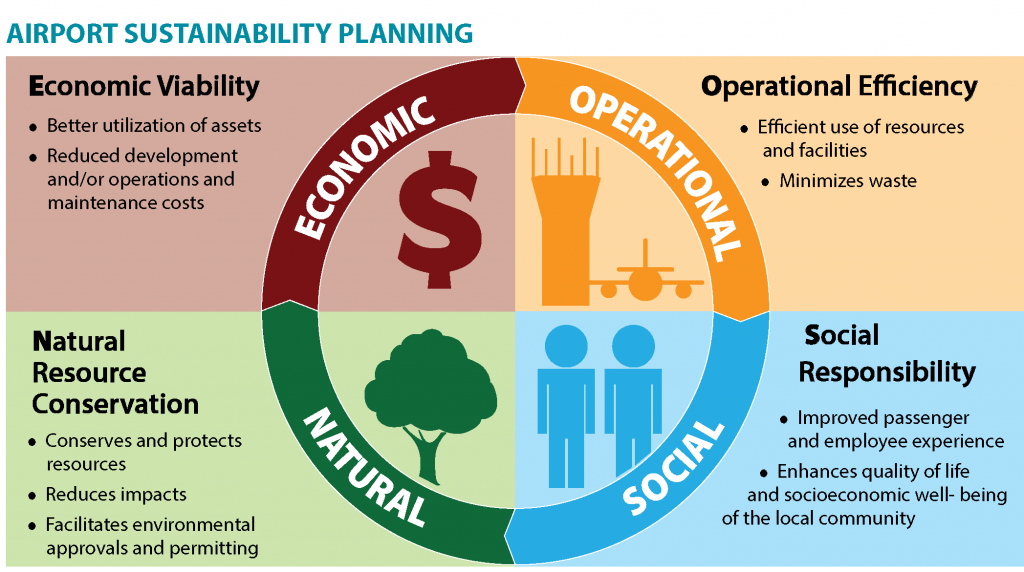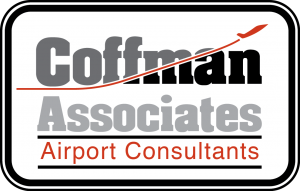What We Do – Airport Sustainability Planning
By Eric Pfeifer, Principal
What is airport sustainability planning?
Airports are more than multi-modal transportation hubs. They are engines that drive local and regional economies; they are systems of complex, symbiotic operations and business entities; they have the potential to impact the surrounding natural environment particularly in terms of its noise and air emissions impacts; and they can have a profound social impact on the local community.
Sustainability planning covers a broad spectrum of airport interests by taking a holistic approach to managing an airport to ensure economic viability, operational efficiency, natural resource conservation, and social responsibility of the airport.

A typical sustainability plan considers a variety of resource categories, including:
• Energy & Climate
• Ground Transportation
• Economic Performance
• Design & Materials
• Engagement & Leadership
• Water & Waste
• Natural Resources
• Human Well-Being
The sustainability planning process involves the following key elements:
Baseline Assessment – Process of collecting and evaluating historical utility and resource usage data and existing sustainability efforts.
Sustainability Goals and Objectives – Establishing long-term goals and methods for achieving those goals within each resource category.
Identify Sustainability Initiatives – Choosing the methods for achieving the sustainability goals and objectives. This element also identifies capital costs, operation & maintenance (O&M) costs, payback periods, metrics, anticipated impacts, and staffing requirements.
Develop Performance Targets – Setting quantifiable targets for future performance.
Monitoring Program – The routine for evaluating performance targets and tracking whether the sustainability plan is trending positively or if adjustments to the program need to be made.
Sustainability Report Card – Creation of a standard form to be completed by the airport staff on a regular basis so that sustainability performance can be understood and made available publicly.
An airport sustainability plan can be a standalone study or incorporated into a traditional airport master plan study. Sustainability plans are eligible for funding through the Airport Improvement Program (AIP) at up to 90 percent with a 10 percent local match. The FAA also has additional programs available to qualified airports to fund sustainability projects including the VALE grant program and the ZEV and Infrastructure Program.
What are VALE grants?
VALE stands for Voluntary Airport Low Emissions. The VALE program began in 2004 to provide funding support to airports to implement projects that improve air quality. To be eligible for VALE grants, an airport must be in areas that are in non-attainment or maintenance of National Ambient Air Quality Standards (NAAQS). Eligible projects include:
• Alternative fuel vehicles
• Gate electrification
• Remote ground power
• Ground support equipment (GSE)
• Geothermal systems
• Solar thermal technologies
• Underground fuel hydrants

What is the FAA’s Zero Emissions Vehicle (ZEV) and Infrastructure Program?
The FAA created this program in 2012 to provide AIP grant funding for projects to help improve air quality. This program provides funds to airports to replace fuel-driven fleet vehicles, ground support equipment (GSE), and associated infrastructure with all-electric ZEVs and vehicle charging stations. To be eligible for this program, an airport must be in the National Plan of Integrated Airports System (NPIAS); however, funding priority is given to airports that are in EPA-designated nonattainment areas.
Coffman Associates is experienced in assisting airports of all types with achieving long-term sustainability. If you would like to find out more about our sustainability planning services, please email me at epfeifer@coffmanassociates.com.
